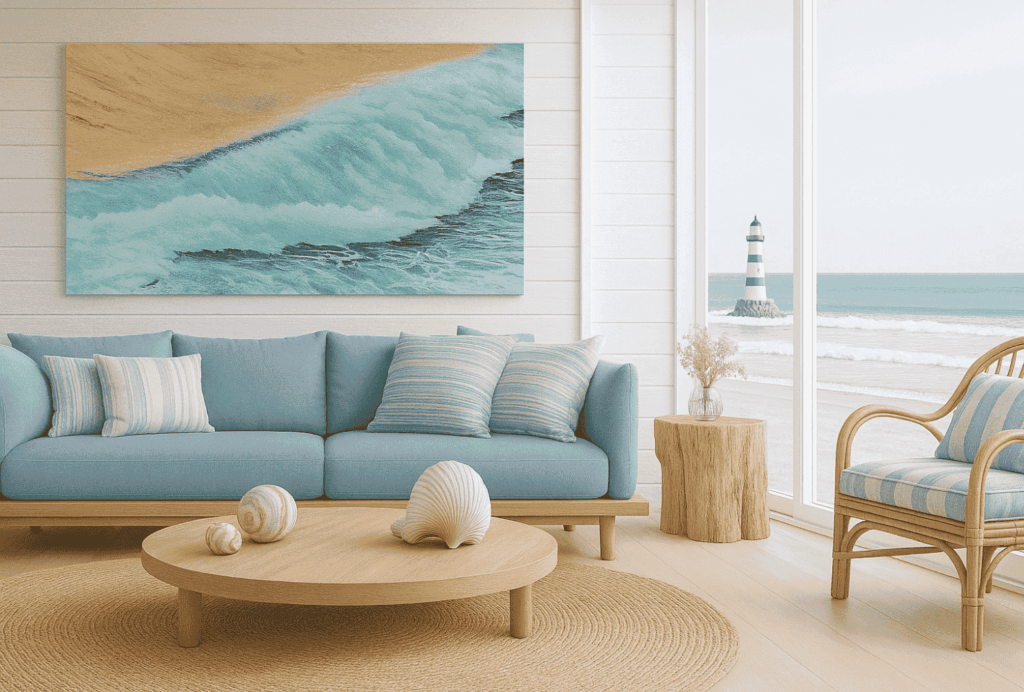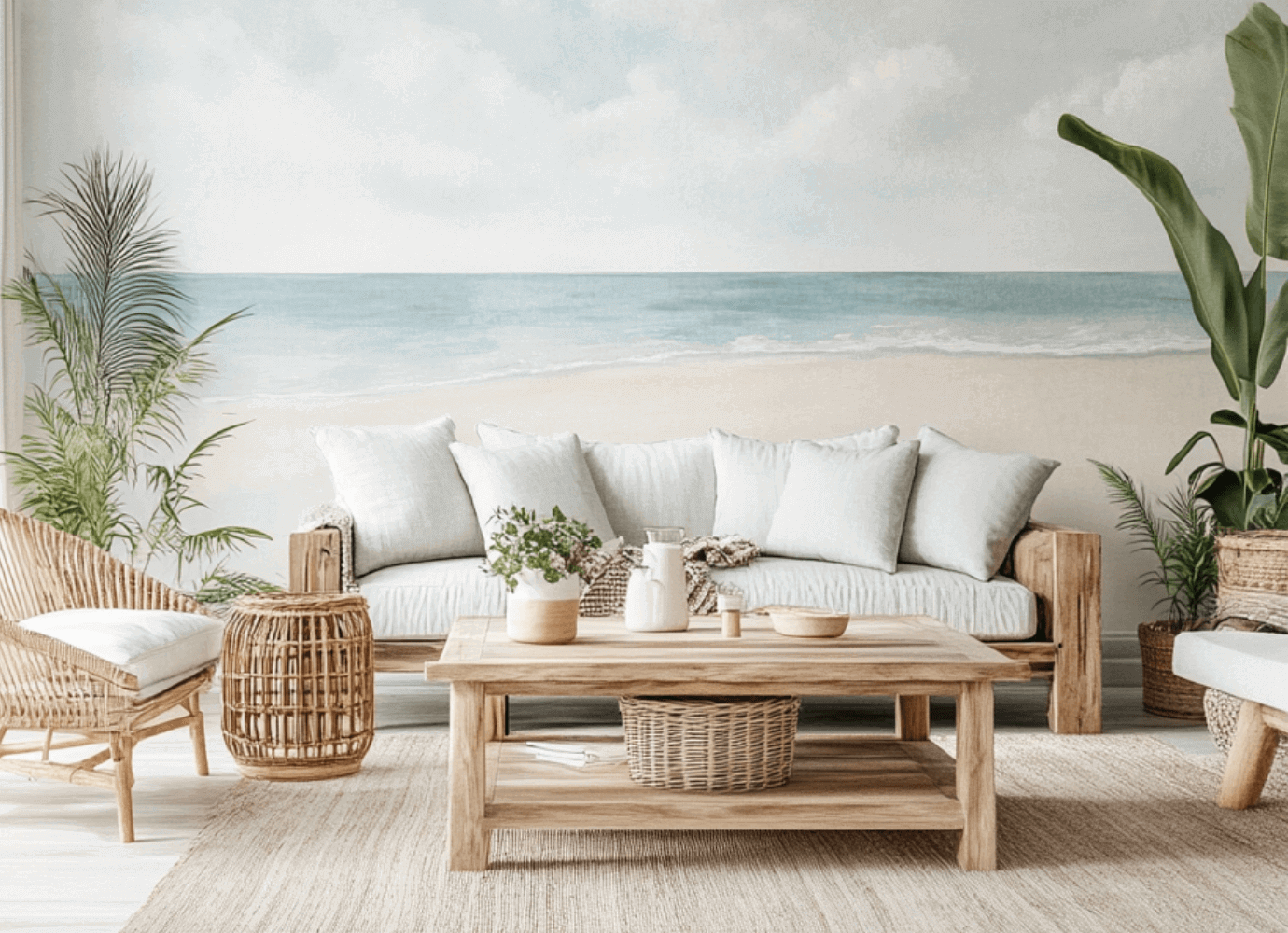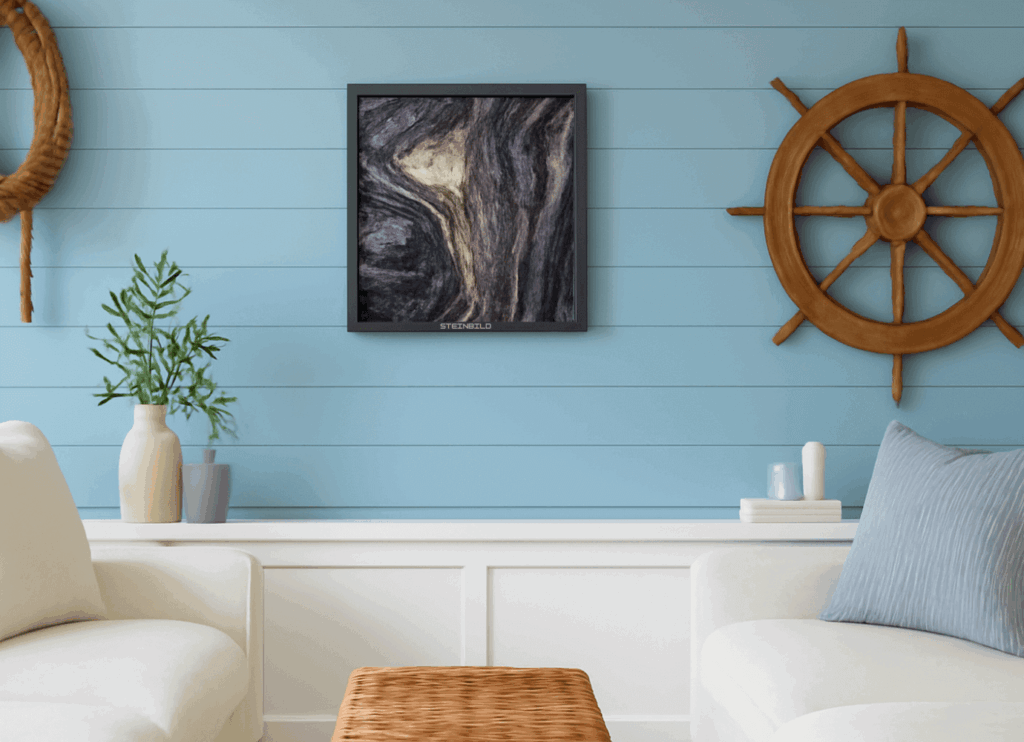News
Sailing Serenity: Incorporating Coastal and Maritime Art into Your Home
Part 1: The Allure and Emotional Impact of Coastal Art
Coastal and maritime art possesses a unique ability to capture the essence of the sea, the spirit of adventure, and the calming rhythm of nature. From a sailboat gliding across the horizon to a serene harbor bathed in early morning light, these artworks evoke powerful emotional responses that can transform the ambiance of a home. Understanding the allure and emotional impact of coastal art is the first step toward incorporating it meaningfully into your living spaces.
1. The Emotional Connection to the Sea
The sea has been a source of inspiration, reflection, and storytelling for centuries. Its presence in art resonates deeply with human emotions.
Calm and Tranquility: The gentle waves of a seaside landscape or a quiet harbor scene convey a sense of peace. The visual rhythm of the water, combined with soft hues and natural lighting, encourages relaxation, making coastal paintings ideal for bedrooms, lounges, or reading nooks.
Adventure and Exploration: Sailboats, ships at sea, or stormy ocean scenes evoke the excitement of adventure and exploration. They remind viewers of journeys taken or dreams of travel, sparking curiosity and a sense of wanderlust within the home.
Nostalgia and Memory: Coastal art often triggers personal memories—vacations by the shore, childhood trips to the beach, or serene moments spent near water. These memories foster emotional comfort and create a connection between the artwork and the viewer’s personal narrative.
Inspiration and Reflection: The vastness of the sea and the interplay of light and color inspire contemplation. Coastal art invites moments of introspection, making it an ideal complement for spaces dedicated to creative pursuits or meditation.
2. Aesthetic Appeal of Coastal and Maritime Art
Beyond emotional resonance, coastal art contributes visual beauty and balance to interiors.
Color Palette: The sea offers a rich spectrum of colors, from deep navy blues to sparkling aquamarines and sandy neutrals. Coastal art leverages these shades to create harmony, contrast, and focal interest in a room. Soft blues evoke calm, while golden sunsets add warmth and vibrancy.
Texture and Brushwork: From the delicate blending of watercolor waves to the bold strokes of acrylic sailboats, texture adds depth and dimension. This variety of techniques provides tactile interest and engages viewers, transforming flat surfaces into dynamic visual experiences.
Composition and Perspective: Coastal scenes often employ expansive perspectives, leading the eye toward distant horizons or inviting viewers into bustling harbors. The use of foreground, middle ground, and background creates depth, making the artwork immersive and engaging.
Light and Atmosphere: One of the most captivating aspects of coastal art is its treatment of light. Sunrise over the harbor, sunlight reflecting on waves, or the soft glow of dusk can dramatically influence mood, infusing rooms with warmth, calm, or energy.
3. Psychological Benefits of Nautical Themes
Art depicting the sea has measurable psychological benefits, influencing mood and well-being.
Stress Reduction: Views of water, even when represented in art, are known to reduce stress and promote relaxation. Coastal paintings simulate the calming effect of nature, providing a restorative experience for the mind and body.
Enhanced Creativity: Nautical imagery often stimulates imagination. The endless horizon, dynamic movement of waves, and interplay of elements encourage creative thinking, making coastal art perfect for workspaces, studios, or creative rooms.
Emotional Regulation: The rhythm and flow of maritime scenes help regulate emotions. Gentle waves and serene harbors create calm, while stormy seas can inspire courage, resilience, and determination.
Connection to Nature: Incorporating representations of the ocean fosters a sense of biophilic connection. Even without a physical beach nearby, maritime art allows homeowners to experience the restorative qualities of nature daily.

4. Symbolism and Storytelling in Coastal Art
Coastal and maritime artworks carry rich symbolism, allowing homeowners to embed meaning and narrative into their interiors.
Sailboats: Represent adventure, freedom, and personal journeys. A sailboat painting can symbolize exploration, growth, or navigating life’s challenges.
Harbors and Docks: Symbolize security, community, and reflection. A serene harbor invites contemplation and serves as a metaphor for finding peace amidst life’s busyness.
Stormy Seas: Reflect resilience, courage, and the beauty of navigating challenges. These dynamic compositions add energy and intensity to interiors, inspiring strength and determination.
Lighthouses and Coastal Landmarks: Represent guidance, hope, and stability. Lighthouses in art convey direction and purpose, offering both aesthetic appeal and metaphorical significance.
Sunsets and Sunrises: Symbolize transitions, new beginnings, and closure. Coastal art capturing these moments adds warmth, depth, and narrative richness to a space.
By understanding symbolism, homeowners can select pieces that resonate personally, creating meaningful connections that extend beyond visual pleasure.
5. The Role of Scale and Perspective
The size and perspective of coastal artwork impact both its visual and emotional effect.
Expansive Landscapes: Large-scale paintings of oceans, beaches, or coastal cliffs draw viewers in, creating immersive experiences. These pieces work well as focal points in living rooms or above beds, transforming walls into windows to the sea.
Intimate Scenes: Smaller artworks depicting boats, piers, or close-up marine details create cozy, contemplative spaces. Perfect for hallways, reading nooks, or offices, these pieces encourage close engagement and reflection.
Perspective Techniques: Horizon lines, vanishing points, and dynamic composition guide the viewer’s eye. A well-constructed perspective invites exploration, adding depth and spatial dimension to interiors.
Balance and Proportion: Large paintings require ample breathing space, while smaller pieces may benefit from grouping or pairing. Proper scaling ensures harmony with furniture and architecture, maximizing aesthetic and emotional impact.
6. Color Psychology in Coastal Art
The colors in coastal and maritime paintings influence mood, energy, and perception.
Blues: Promote calm, focus, and introspection. Light blues create serenity, while deep blues convey depth and stability.
Greens: Evoke growth, renewal, and connection to nature. Coastal scenes with greenery along shores enhance a sense of vitality.
Warm Tones: Sunsets, golden sands, and warm reflections bring comfort, optimism, and energy to a room.
Neutrals: Sandy beiges, soft whites, and muted grays provide balance, acting as a neutral backdrop that enhances other decor elements.
Contrast and Accent Colors: Strategic use of contrasting or vibrant accent colors draws attention to focal points, such as a sailboat or lighthouse, emphasizing key elements and adding visual interest.
7. Connecting with Personal Narrative
The most impactful coastal art reflects personal experience and aspiration.
Travel Memories: Art depicting favorite coastal regions or seascapes recalls cherished vacations, evoking nostalgia and joy.
Life Aspirations: A painting of a sailboat heading toward the horizon may symbolize ambition, freedom, or the pursuit of dreams.
Daily Inspiration: Coastal art can act as a daily reminder of tranquility, courage, or exploration, enhancing motivation and emotional well-being.
Family and Home Connection: Nautical themes resonate with shared experiences, such as family beach trips, fostering connection and storytelling within communal spaces.
8. Integration with Interior Design
Coastal and maritime art complements various interior styles, offering versatility and cohesion.
Coastal/Beach Themes: Naturally enhances blue, white, and sandy tones, creating a cohesive, relaxing atmosphere. Accessories like driftwood, shells, and linen furnishings amplify the theme.
Modern and Minimalist Interiors: Bold, abstract maritime pieces provide contrast and focal interest without overwhelming simplicity. Strategic placement and lighting maximize visual impact.
Traditional Interiors: Realistic oil or watercolor seascapes add elegance and sophistication, harmonizing with classic furniture and warm wood tones.
Eclectic Spaces: Mixing coastal art with other thematic or textural elements introduces depth, energy, and storytelling, blending seamlessly into diverse décor arrangements.
9. Light and Atmosphere
Lighting dramatically affects how coastal art is perceived.
Natural Light: Sunlight enhances colors, reflections, and textures, making waves shimmer and horizons glow. Avoid direct exposure that may fade pigments.
Accent Lighting: Adjustable picture lights or spotlights emphasize texture and depth, highlighting focal points.
Ambient Lighting: Soft room lighting complements the mood of coastal art, whether serene dawn, bright midday, or golden sunset scenes.
Dynamic Effects: Light and shadow interplay with the painting’s subject, creating evolving visual experiences throughout the day.
10. Conclusion: Why Coastal and Maritime Art Transforms Spaces
Coastal and maritime art offers more than visual beauty—it shapes mood, evokes emotion, and connects viewers to the vastness and serenity of the sea. Through thoughtful selection, understanding symbolism, considering color and scale, and aligning with personal narrative, these artworks transform interiors into immersive, meaningful environments.
Whether capturing the gentle calm of a harbor, the adventurous energy of a sailboat, or the golden glow of a sunset, coastal art enriches homes with serenity, inspiration, and timeless elegance. By embracing its emotional and aesthetic power, homeowners can cultivate spaces that reflect personality, inspire daily living, and celebrate the enduring allure of the sea.
Part 2: Selecting the Right Coastal and Maritime Art
Selecting the perfect coastal and maritime artwork for your home requires a thoughtful approach that balances aesthetic appeal, emotional resonance, and personal storytelling. The right piece does more than decorate a wall; it transforms a space, enhances mood, and reflects your lifestyle and aspirations. From tranquil harbors to dramatic ocean vistas, each artwork has the power to create an immersive experience. This section will guide you through selecting coastal and maritime art that aligns with your home, décor, and emotional intentions.
1. Assessing Your Space and Its Purpose
Before choosing artwork, it is essential to understand the function and atmosphere of each room.
Living Rooms: Often the central hub of a home, living rooms are perfect for statement pieces. Large-scale seascapes, panoramic beaches, or sailboats on the horizon act as focal points, anchoring the room and enhancing visual interest. Consider whether you want your living room to feel serene, energetic, or adventurous, as this will influence color and subject choice.
Bedrooms: Bedrooms serve as personal retreats. Art depicting calm waters, soft beaches, or gentle harbors encourages relaxation and reflection. Pastel blues, soft whites, and muted sands create a restful atmosphere. Avoid overly busy or dramatic seascapes that could disturb the calm energy of the space.
Workspaces and Studios: Creativity and focus are enhanced by coastal art that inspires and motivates. Sailboats navigating open waters, waves in motion, or abstract interpretations of the sea encourage imaginative thinking. Color psychology plays a role here—blues and greens foster concentration, while warmer tones like gold and coral energize the mind.
Entryways and Hallways: Transitional spaces offer opportunities for first impressions. Medium-sized coastal paintings or prints of piers, lighthouses, or coastal towns add charm and narrative, immediately engaging visitors and setting the tone for the home’s décor.

2. Choosing Themes and Motifs
The theme and subject matter of your artwork influence both its emotional and aesthetic impact.
Sailboats and Yachts: These motifs symbolize freedom, adventure, and personal journeys. A painting of a sailboat heading toward the horizon inspires exploration and optimism.
Harbors and Coastal Towns: These scenes evoke community, nostalgia, and reflection. Quiet harbors, bustling docks, or quaint seaside villages provide a sense of place and history.
Lighthouses: Represent guidance, hope, and resilience. A lighthouse artwork adds symbolic depth, making it ideal for spaces intended for contemplation or inspiration.
Beaches and Shorelines: Sandy beaches, rocky coastlines, and tidal pools convey serenity and natural beauty. They are versatile, complementing both minimalist and traditional interiors.
Stormy Seas and Dramatic Waves: While intense, these compositions bring energy and dynamic tension. They symbolize courage, resilience, and the unpredictability of life.
Sunsets and Sunrises: Coastal artworks featuring golden horizons evoke warmth, reflection, and the passage of time. They are perfect for living rooms or bedrooms seeking ambiance and tranquility.
Abstract Interpretations: Abstract maritime art focuses on color, movement, and emotion rather than literal depiction. These pieces integrate beautifully into modern, eclectic, or minimalist interiors.
By considering theme and motif, you can select artwork that resonates personally and complements the intended mood of each space.

3. Color Considerations
Color plays a pivotal role in enhancing atmosphere and harmonizing with existing decor.
Blues and Aquas: Evoke calm, depth, and introspection. Light blues create serenity, while deep navy conveys stability and sophistication.
Greens and Turquoises: Connect to nature, renewal, and balance. They are ideal for spaces where freshness and vitality are desired.
Warm Tones: Golden sands, coral reflections, and sunsets introduce warmth, optimism, and energy.
Neutrals: Sandy beiges, soft whites, and muted grays provide versatile backdrops that allow other elements of décor to shine.
Accent Colors: Vibrant accents, such as the red of a lighthouse roof or bright sails, draw attention to focal points and add visual interest.
When selecting coastal art, consider both dominant and accent colors to ensure harmony with furniture, wall colors, and other decorative elements. Color also influences mood; soft palettes for relaxation, vibrant tones for energy, and balanced combinations for visual intrigue.
4. Scale and Proportion
The size of artwork relative to your space significantly affects visual balance and impact.
Large-Scale Pieces: Expansive seascapes or panoramic beaches create immersive experiences and dominate focal walls. They are ideal above sofas, beds, or fireplaces, drawing viewers into the scene.
Medium-Sized Works: These are versatile and can complement other décor or be grouped into gallery arrangements. For example, a set of three harbor paintings can narrate a story from sunrise to sunset.
Small Pieces: Perfect for intimate spaces, desks, shelves, or secondary walls. They invite close engagement and reflection, offering personal moments of connection without overwhelming the room.
Proportion and Balance: Artwork should feel harmonious with furniture and architecture. A small painting on a large wall may feel lost, while an oversized piece in a confined space can dominate excessively. Proper scaling ensures both aesthetic pleasure and emotional resonance.
5. Medium and Material Selection
The medium of a coastal artwork affects its texture, depth, and overall atmosphere.
Oil Paintings: Rich, textured oils are timeless and elegant, ideal for traditional or formal interiors. They convey depth and presence, making the viewer feel immersed in the scene.
Acrylics: Vibrant and versatile, acrylics suit modern and contemporary spaces. Bold colors and layered textures bring energy and immediacy.
Watercolors: Delicate, soft, and ethereal, watercolors create subtle atmospheres. They are perfect for bedrooms, studies, or calming retreats.
Prints and Digital Art: Accessible, versatile, and easy to rotate, prints allow homeowners to experiment with seasonal displays or thematic series without high investment.
Mixed Media: Combining materials—such as acrylic with texture paste or digital overlays—adds depth and dimensionality, making artworks more tactile and engaging.
6. Framing and Presentation
The frame is integral to how coastal art interacts with a space and complements décor.
Traditional Frames: Ornate wood frames suit classic interiors, enhancing realism and elegance.
Minimalist Frames: Slim, clean frames in black, white, or natural wood highlight the artwork without distraction, perfect for modern spaces.
Floating Frames: Canvas works in floating frames gain gallery-style depth, ideal for bold or abstract pieces.
Matting: Mat boards provide breathing space, emphasize composition, and protect artwork. Neutral mats complement subtle scenes, while colored mats enhance vibrancy.
Framing decisions influence both the aesthetic impact and the longevity of artwork, ensuring that pieces remain visually appealing for years.
7. Personal Resonance and Storytelling
Coastal and maritime art is most impactful when it reflects personal experiences, aspirations, or memories.
Travel Memories: Paintings of familiar coastlines or dream destinations evoke nostalgia and personal connection.
Life Aspirations: Sailboats heading toward distant horizons symbolize ambition, exploration, and the pursuit of dreams.
Emotional Anchoring: Artwork can serve as a daily reminder of calm, courage, or inspiration, reinforcing emotional well-being.
Family and Shared Stories: Coastal art resonates with shared experiences—family beach trips or seaside adventures—strengthening communal spaces and adding narrative depth.
8. Coordinating Multiple Pieces
Combining several artworks creates layered storytelling and visual interest.
Gallery Walls: Arrange multiple coastal paintings of different sizes or perspectives to tell a cohesive story, such as a journey from sunrise over the beach to a sunset at the pier.
Thematic Cohesion: Maintain a consistent theme, such as lighthouses, sailboats, or coastal towns, while allowing variation in medium or perspective.
Spacing and Alignment: Proper spacing enhances breathing room and focus. Experiment with symmetrical or staggered arrangements to balance visual rhythm.
Series and Triptychs: Grouping artworks into series creates a narrative arc and immersive experience, encouraging viewers to engage with each piece individually and collectively.
9. Practical Considerations
Lighting: Coastal artwork shines with natural or accent lighting. Avoid direct sunlight that may fade pigments.
Placement Height: Hang at eye level (approximately 57–60 inches from floor to center). Adjust based on furniture height and wall proportions.
Environmental Factors: Consider humidity, sunlight, and temperature, which can affect certain media like watercolor or paper prints.
Rotation and Updates: Consider rotating artworks seasonally, displaying calmer scenes in winter and vibrant ocean scenes in summer, keeping interiors fresh and dynamic.
10. Conclusion: Curating Coastal Art with Intention
Selecting the right coastal and maritime artwork involves a balance of aesthetics, personal resonance, and spatial consideration. By evaluating your space, choosing themes, considering color, scale, and medium, and aligning pieces with personal narratives, you can curate a home that is visually stunning, emotionally enriching, and deeply meaningful.
Thoughtful coastal art transforms interiors into immersive experiences, connecting inhabitants to the serenity, adventure, and timeless beauty of the sea. Whether it’s a gentle harbor at dawn, a dynamic sailboat on the open water, or a dramatic sunset over a rocky coast, each piece tells a story, evokes emotion, and inspires daily living. By selecting coastal art with intention, your home becomes a canvas of beauty, reflection, and endless inspiration.
In addition to aesthetic and emotional considerations, practical elements should not be overlooked when selecting coastal and maritime art. The choice of material and finish, for example, influences durability and maintenance, ensuring your investment remains vibrant over time. Consider canvases with protective coatings for longevity or framed prints under glass to prevent fading. Furthermore, personal engagement with the artwork is crucial—choose pieces that you find yourself returning to, that spark conversation, or that evoke a sense of calm or inspiration each time you pass by. By taking the time to evaluate not just the visual impact but also the practical and emotional resonance, you ensure that every artwork you bring into your home enhances both its beauty and its lived experience. Thoughtful curation transforms walls into immersive narratives, where every wave, pier, or lighthouse conveys meaning and invites reflection. Ultimately, selecting coastal art with intention allows your home to become a space of personal storytelling, serenity, and inspiration—a sanctuary where the enduring beauty of the sea is never far from sight, and where each day begins and ends surrounded by the calming and invigorating power of maritime imagery.

